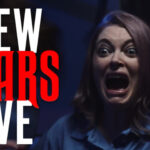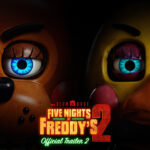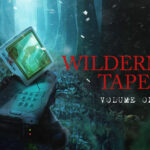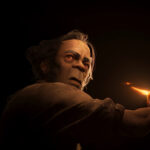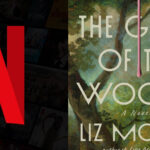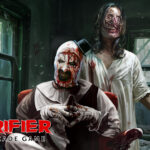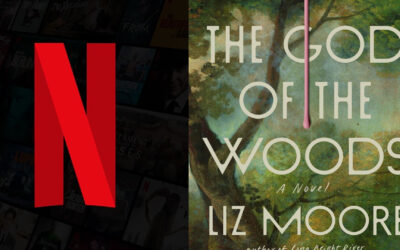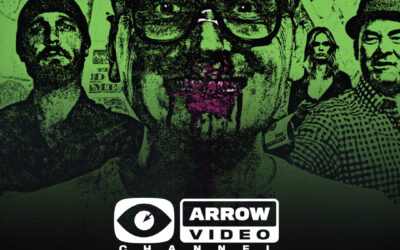One of the most important parts of a film is its score and soundtrack. Even if you don’t realize it, the music is there to guide you through the movie and influence your mood, the setting, and the tone of the movie.
Recently, I had the opportunity to interview a fantastic composer, musician, and Grammy nominee Charlie Clouser who has composed a long list of scores for television, film, and games including for the ‘Saw’ franchise, ‘Wayward Pines’, and the iconic opening score of ‘American Horror Story’. You may recognize Clouser for his work as a musician. He was one of the founding members of Nine Inch Nails. Clouser still works in the music industry today, creating remixes for musicians like Marilyn Manson and Rob Zombie’s band White Zombie.
Horror Fuel: “You have been involved with various roles in the music industry for a while. How old were you when you began playing music and what was your first instrument?”
CC: “When I was around six years old I started taking piano lessons, with limited success and enthusiasm, but when I was about eight I started playing the drums. To an eight-year-old boy, actually being encouraged to hit things was a dream come true, so drums were my main instrument throughout my high school years. When I got to college and acquired my first synthesizer, I got much more serious about developing my keyboard and piano skills.”
Horror Fuel: “How did you get involved with Nine Inch Nails (I’m a fan by the way)?”
CC : “In the early nineties I was living in Los Angeles and working as a programmer on television and film scores for an Australian composer, and on the side doing a brisk business of programming drums and synths on albums for various heavy bands like Prong and White Zombie. An old college friend was a producer on the music video for the Nine Inch Nails song “Happiness In Slavery”, and they needed some sound design work to embellish the sounds of the mechanical chair that tortures the performance artist Bob Flanagan to death in that clip. Since I was good with samplers and manipulating sounds, I got the call, and instead of going to a more conventional sound design and audio sweetening shop, we did all of the sound effects for that music video at Trent’s studio. We used recordings that I had collected of electric motors, jackhammers, and dentist’s drills, and manipulated those sounds in the primitive samplers of the day to create the sound effects we needed. We had allocated two days to get the job done but finished in only a few hours, and spent the rest of the day playing video games and hanging out, and then Trent asked if I’d be up for programming the sampled drum reinforcements on Marilyn Manson’s first album. A couple of months later, the Manson album was finished but Trent kept thinking up stuff for me to do and I sort of never left. I wound up accompanying the band on tour and setting up the hotel room rig to work on songs, remixes, and the soundtrack album for Natural Born Killers. I remixed a few songs from the NIN album “The Downward Spiral”, and after a few months of that I was drafted into playing keyboards in the NIN live band. Eventually I moved to New Orleans at the end of the Downward Spiral tour, and that’s where I stayed from 1994 until 2001, when I left the band and returned to Los Angeles to jump back into scoring films.”
Horror Fuel: “How did you transition from the stage to the studio, creating for series and films?”
CC: “Even before I got involved in the record industry side of things, I had a few years of experience working as the programmer on television and film scores. The only “real job” I’ve ever had was the two years I spent as the computer and software guru at the Sam Ash music store in Manhattan in the late eighties, fresh out of college, and right when MIDI and computer software was really taking off. One of my customers there, an Australian composer named Cameron Allan, hired me away from the store and hired me to program drums and synths, make scary sounds, and generally ride herd on all of the gear that we used on the score for the CBS Television drama “The Equalizer”. So by the time I was leaving NIN in 2001 and getting back into the scoring side of things, it was more of a return to what I had been doing earlier as opposed to making a fresh start. Even though I’d taken 15 years off to play around in the record industry, I already had a good handle on the sounds, workflow, and musical vocabulary involved in the scoring world, so it wasn’t a difficult transition for me to make.”
Horror Fuel: “How different is the process of composing a song versus composing a score?”
CC: “One aspect of scoring to picture that’s always been interesting to me is the fact that the form of a piece is completely dictated by the action on the screen. I had always felt a little bored when working on conventional rock songs that had the familiar verse-bridge-chorus structure, and I guess that’s why I concentrated more on doing remixes, where I could really mess with the structure and get away from those familiar forms. That’s also what interested me in working with NIN, since many of those songs did not follow the established conventions of rock music that I had often felt bored with. This was especially true on “The Fragile”, where there were lots of long pieces, quiet little interludes, instrumental bits, and music that was a little left of center in terms of structure. I really like the process of scoring and developing musical ideas whose shapes are formed in response to the story and action on the screen, since that gets me about as far away from the old verse-chorus mode as I can get. At the same time, that process is not the same as just making free-form instrumental music, since you are reacting to and collaborating with the film, the actors, the director, and the story. It’s kind of an ideal situation for my creative brain, since I still feel like I’m creating alongside someone else, except the score is ebbing and flowing in response to the story, as opposed to in response to other musicians, like you would when you lay out to make space for a guitar solo or the vocals on the verse of a song.”
Horror Fuel: “You have composed so many scores, including for the Saw franchise, more recently for Wayward Pines and the iconic main title theme for American Horror Story. Do you have a favorite?”
CC: “I’ll have to borrow a line from Hans Zimmer, who, when asked which of his scores was his favorite, replied, “I haven’t written it yet”. “When I read that in some interview he had done, I thought, “THAT’S what I was trying to put my finger on!” Like many composers, I am probably my own harshest critic, and would rather putter about with a new half-finished piece of music than sit and listen to my past work and revel in the past. But, I’ll still attempt to answer the question. Two of my favorites are my scores for James Wan’s films “Dead Silence” and “Death Sentence”. The first one was pretty coherent from a thematic standpoint, more so than many of my scores, and the second one had a nice variety of emotions and approaches in the context of a more traditional thriller film, as opposed to the all-out horror assault that many of the SAW movies are. Both of those were lots of fun to work on, and I think I learned a lot in the process. Another favorite of mine was the second film I ever scored, which almost nobody has seen, a little psychological thriller called “Deepwater” that starred Lucas Black and Peter Coyote. I had the time and luxury of creating a really chaotic head-trip of a score by banging on guitars with pencils, using cheap circuit-bent keyboards and toys, and generally having a great time making some thoroughly weird music.”
Horror Fuel: “You recently created the arrangement for Marcus Dunstan’s thriller ‘The Neighbor‘, which was just released on DVD. How do you hope that the music will make the audience feel?”
CC: “I’d hope that the score in “The Neighbor” will just raise the level of dread and anticipation the audience is feeling. There’s a lot of tension and suspense, since it’s not purely a straight-up horror film, and I was able to use a more low-energy approach than on many projects I’ve done. I didn’t use much in the way of orchestral sounds at all – it was mostly done with guitars and processing, along with some electronic percussion, and I thought this was a nice change of tone. It was nice to get into more of a claustrophobic sound and away from the big, splashy, epic sounds that I use in some of my scores. I used no strings, no big “movie drums”, and no sounds that didn’t sound “local” to the setting that the film takes place in. Since the movie is set in the rural south, I stuck mainly to guitars because I could start the film out with those sort of “dirt road” sounds and then gradually morph those tones into the dread-inducing stuff later in the film while still maintaining some continuity of tone.
Horror Fuel: “So many films use that orchestra style score. You seem to go in a different direction (thank you). Is that a personal preference? Do studios give you free reign?”
CC: “My background is more in the areas of working with synthesizers and manipulation of sampled sounds, so that’s just a natural direction for me to go. I do use quite a lot of orchestral sounds, but I usually process or manipulate them somewhat so they’ll fit a little better with the rest of my sound palette. I often use pitch shifters to lower the pitch of sampled orchestral sounds, which tends to give them a more grungy and girthy feel, and I also use time-stretching to move those sounds a little bit outside the type of tone that we’re all used to, while still retaining a familiar sonic footprint. I tend to like my scores to sound a little murky and dark, and using a mix of sounds like these helps me get into that territory. The studios and directors generally do give me free reign to use whatever sounds I like, and if they want a conventional orchestral score then there are plenty of composers that can give them that, so by the time I’m working on a score pretty much everyone is on board with the sonic palette I’m going to bring to the table.”
Horror Fuel: “Is it easier or more difficult to compose for the horror genre compared to the music you create for a series like ‘Las Vegas’?”
CC: “I think it’s much more difficult to compose in the horror genre than when I’m doing a series like “Las Vegas”, although that can be challenging as well, but mainly due to the deadlines! A show like “Las Vegas” has such a wide variety of genres that I need to cover in each episode, and that’s always fun to be able to swerve between different styles, but in a horror film I really need to have more of a coherent thematic approach, where the musical themes and sounds gradually build to a conclusion. That requires more of a zoomed-out view, and there’s not much room for little odd-ball cues that don’t fit with the big picture.”
Horror Fuel: “Not only do you create scores for movies and series, you also work with musicians like Marilyn Manson and Rob Zombie , who are amazing. Can you tell us a little about that?”
CC: I’ve done a lot of remixes and programming for artists on the heavier, darker side of the musical spectrum, and that’s just a natural fit for the type of sounds I tend to create. Most of my favorite bands have a pretty aggressive sound, so adding some distorted drum samples and harsh synth parts on albums by White Zombie, Prong, or Helmet was right down my alley. Rob Zombie was enthusiastic about what I could bring to his records pretty early on, even when the rest of the band wasn’t so sure if adding electronic stuff would work with their super heavy sound. But Rob persevered and had confidence that the synths and programming would make them sound even heavier, and in the end he was right. It was great to be able to expand on the stuff I added to their albums by doing so many remixes for White Zombie after the albums were done, and that let me take some of those songs to another level of programming mayhem that would have been too much for the album itself. Manson also had a similar view; his band started out with more conventional hard rock instrumentation, but with each new album and remix he took it further into the hard electronic / industrial direction, and it turns out this was a great match for his writing and vocal style. All of the artists I’ve worked with in have had a similar outlook with respect to combining heavy rock guitars and drums with some of the more mechanized and industrial influenced stuff that I like to do.”
Horror Fuel: “How do you go about the process of remixing someone’s music?”
CC: “I generally approach a remix a little differently from some remixers who might keep the lead vocal and write a whole new track underneath. I prefer to pillage the original recording for as much raw material as I can, taking bits and pieces of the drums and guitars and then processing and manipulating them so that the end result still contains as much of the original DNA as possible. I don’t start with the vocal and then build the track around it, I tend to start with the drum and bass groove and get that sounding tough, and then begin building the track around those elements using samples of the original guitars. When that bed starts to take shape, then I can move on to the vocals and see how I can fit them in over the slab that I’ve built. I also like to really mess with the song arrangement, creating really long intro builds and dub sections in the middle during which I can play with lots of head-trip effects like long decaying echoes and stuff. Often I’ll eliminate a verse and a chorus to give me more long sections in which to play around and just let the crazy effects ring out over a churning groove. Those are usually my favorite parts of the track when it’s all said and done!”
Horror Fuel: “What is your favorite horror film and why?”
CC: It’s hard to pick just one, but I’d have to go for Kubrick’s “The Shining”. It really stands up to repeated viewing, and for me it’s about as terrifying as a film can be. I’m a huge fan of all of Kubrick’s films, so even though some horror purists don’t hold The Shining on a pedestal, I think it’s right up there. The stark framing that Kubrick uses, and a fantastic cast operating at their limits, plus the score with all those chaotic pieces by Penderecki, Bartok, and Ligeti alongside the somber synth tones that Wendy Carlos and Rachel Elkind did, it all comes together to put The Shining at the top of my list.
